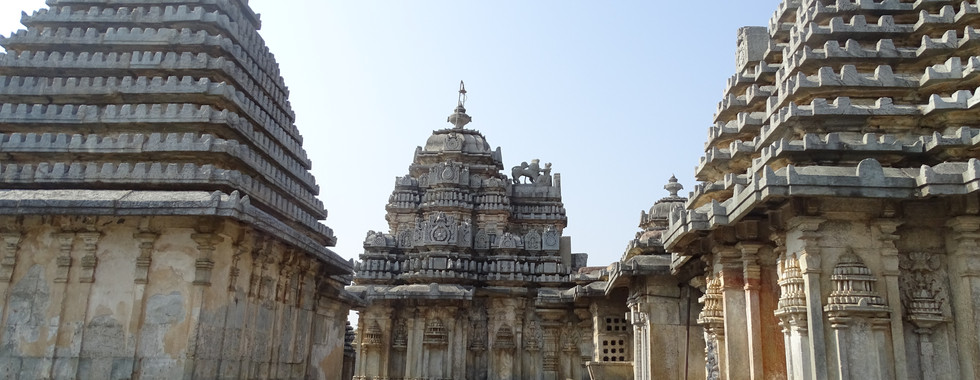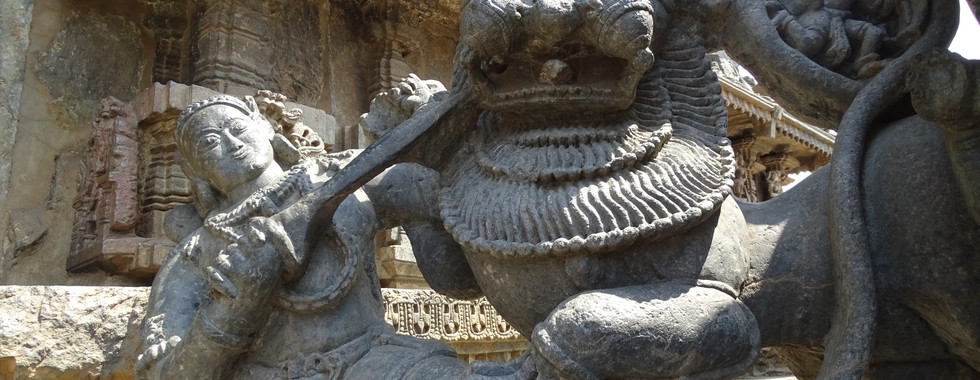People who love travelling will be most efficient when they are on the move. Same applies to some extent to me too. From being a sleepy head in the morning to be up and ready to hit the road by sunrise is one such transition usually seen, in most cases at least. In this trip though, the second day was a tight one for we had to reach Bangalore for the night train back to our workplaces with still almost 50% per cent of the planned places left unchecked in our list.
The first in the list was The Lakshmi Devi Temple in the small village of Doddagaddavalli. Some 16 km from the district capital of Hassan, the place is very less visited, at least at the time of our visit. Its location, away from the highway could also be a reason for this place to be visited only by people who are on a full-on exploration of Hoysala structures. The road connecting the village to the main highway could easily get choked with two vehicles. That's the remoteness of this temple. Nevertheless, you shouldn't be missing this one for its ultimate peaceful experience and the photogenic views.
The Lakshmi Devi temple is considered to be one of the earliest temples constructed in the Hoysala architecture styles. The temple comes to view from a distance itself and stands out from its surrounding with its unique structure. The temple is constructed Chatuskuta style (4 towers and shrines ) housing idols of Lakshmi, Kali, Vishnu and Bhoothanatha Linga. The statue of Lord Vishnu was stolen some 300 years ago. The emblem of the Hoysala Empire, a young man named Sala fighting a tiger, can be seen distinctively carved out of stones at many places. After spending some considerable amount of time enjoying the quiet surroundings we to our next destination. Chennakesava temple, Belur.
Apart from its religious importance, Belur Chennakesava temple is a popular tourist spot and has shown it's presence in several Indian films. The temple was built in the 12th Century by the then ruler of the Hoysalas Vishnuvardhan when the town of Belur was the site for the capital of the Hoysala kingdom. The temple, built by the best architects and artists of the time is considered one of the peaks of architectural achievements during the Hoysala period. It took almost 103 years for the completion of the temple complex. Be prepared to spend at least 2 hours here to cover all the temple complex and all the amazing artwork on the walls.
Vishnuvardhana moved the capital of Hoysala empire from Belur to Halebeedu and started constructing the Hoysaleswara temple there. Halebeedu is another majestic architectural marvel of the Hoysalas and legend says it is only half done. The detailing on the walls and pillars confirms the fact that this took hard work of 4 generations over 190 years. The temple comprises of 108 pillars each of different design. And the temple walls are decorated with a stone carving belt that depicts different Indian mythologies including the Mahabharata and the Ramayana. A few unfinished portions can be seen in carvings on the walls. Temples of Halebeedu and Belur were the main targets of attacks during the invation by the Delhi sultanate.
Next up was Belavaadi Veeranarayanaswami temple. Believed to be built before the Belur and Halebeedu temples, this temple has an unusual architecture from other Hoysala constructions. The temple comprises of three shrines, two on either sides of the entrance facing each other and one at the longer end of the large hall. One unique feature of this temple is that the two shrines at the entrance differ in their shapes (one is start shaped and the other square shaped) but their external ornamentation hides the difference.
It was past lunch time and we have already near our tolerance time to reach start our journey back to Bangalore. But we've come this far, so decided to tick off one more temple from the list of hidden gems of Hassan. Our last place in the itenary was the Lakshmi Narasimha Temple at Javagal. The Lakshmi Narasimha temple, is a Vaishnava temple, with the half man-half lion incarnation of Vishnu - Narasimha as the main deity. The Narasimha here is accompanied by his consort, goddess Lakshmi. This is an example of the newer Hoysala style of temples.
"God is in the details" - Ludwig Mies van der Rohe
A bit later than our planned times, we started back to Bangalore after a good lunch from a roadside Dhaba. It was a race against time before we could catch our train two stations after our original boarding station. Always keep enough buffer time in your itenary.













































































Comments